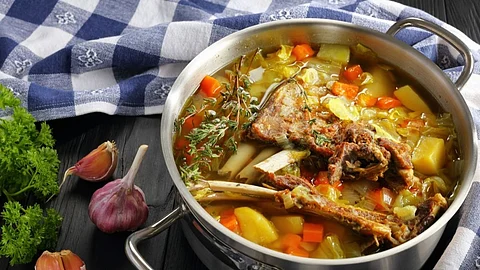
- Destinations
- Experiences
- Stay
- What's new
- Celebrating People
- Responsible Tourism
- CampaignsCampaigns
- SubscribeSubscribe
- Buy Now

Iceland is shrouded with harsh relentless winter most of the year, the average temperature in January being around -1°C, and the days are short and dark. These conditions have shaped a culinary tradition that emphasises warmth and sustenance. The safest country in the world, Iceland is a haven for meat lovers and Icelandic cuisine, rich in flavours, primarily revolves around locally sourced fish, lamb, dairy, and rye.
Join us on a virtual culinary tour of some of the most popular Icelandic foods that keep you warm in winter, and how you can make them at home.
Skyr is an iconic Icelandic cultured dairy product that is similar to yogurt, but thicker and creamier. It is made from skimmed milk that is heated, inoculated with a special bacteria culture, and strained to remove the whey. Skyr is high in protein and calcium, and low in fat and sugar.
It is a versatile ingredient that can be eaten plain, flavoured with fruit or honey, or used in baking and cooking. Skyr is also used to make a delicious cake called skyrkaka, which is skyr cake with blueberries and whipped cream.
Rúgbrauð, which means “rye bread”, is a dense and moist bread that is traditionally baked in wooden boxes near hot springs. The geothermal heat creates a slow and steady baking process that results in a sweet and dark bread that has no crust. Rúgbrauð is a staple in Icelandic cuisine. This bread is commonly enjoyed with a spread of butter, paired with cheese, or served alongside smoked fish or jam.
It also plays a central role in a beloved Icelandic dessert known as rúgbrauðsís – a novel rye bread ice cream. The bread's unique preparation method and its role in both savoury and sweet dishes underscore its significance in the culinary landscape of Iceland, offering a taste of tradition with every bite.
Kjötsúpa, which means “meat soup”, is a classic Icelandic dish that dates back to the Viking era. This robust soup is made from lamb, root vegetables, herbs, and sometimes barley or rice. It is a hearty and nourishing soup and an ideal choice for combating Iceland's cold, blustery weather.
Kjötsúpa is often eaten as a main course, with bread and butter on the side. This soup holds a special place in Icelandic culture, particularly during the Þorrablót midwinter festival. This celebration, deeply rooted in Icelandic tradition, sees Kjötsúpa enjoyed widely as it honours the country's heritage and culinary history.
Plokkfiskur, or "plucked fish", a cherished Icelandic staple, epitomizes comfort food in this Nordic nation. Crafted from a wholesome mix of boiled fish, potatoes, onions, and a creamy béchamel sauce, it's a dish celebrated for its simplicity and heartiness. Ubiquitous in Icelandic homes throughout the year, Plokkfiskur becomes particularly essential during the frosty winter months.
The recipes remains almost the same from kitchen to kitchen, and it is served in many restaurants in Reykjavik and around the countryside. Plokkfiskur is usually eaten with rye bread and butter, and sometimes with boiled eggs and pickled beets. It is a simple, but satisfying and comforting meal that fills you up and warms you from the inside.
Although not the best sight for many, Svið, or sheep’s head, is a local Icelandic speciality and is definitely full of protein. Svi originated during a time when people could not afford to discard any part of a slain animal. It is offered as part of þorramatur, a buffet of several traditional Icelandic foods, notably at the orrablót midwinter celebration. Be sure to try the cheek, which is said to be the meatiest and the tastiest.
